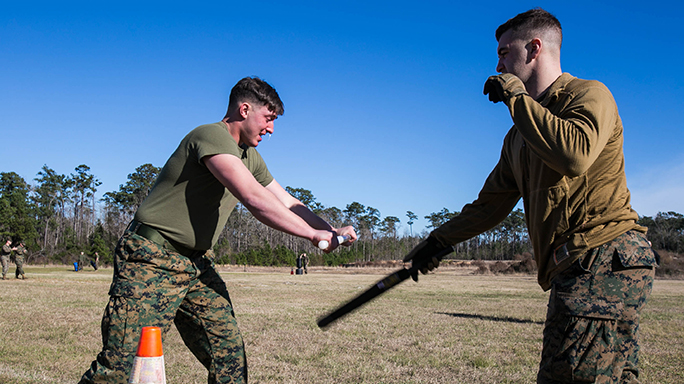The following is a release from Lance Cpl. Luke Hoogendam, II Marine Expeditionary Force:
Marines with Combat Logistics Battalion 22 endured multiple stressors in an intense non-lethal weapons training course, Jan. 11-22, in preparation for an upcoming deployment with the 22nd Marine Expeditionary Unit.
- RELATED STORY: Securing Afghanistan With The Marines of Second Platoon
The non-lethal weapons training course is a two-week course that challenges each Marine to perform under a high intensity situation. The course teaches Marines everything from joint manipulation to riot control.
Advertisement — Continue Reading Below
“The purpose of this course is to gain compliance without using lethal force,” said Cpl. Hayden Jolly, an artillery section chief with the unit.
If a situation does escalate while on deployment, we can use this training to our advantage, according to Jolly.
The Marines have been enrolled in the course for a week and have started studying the effects and purposes of oleoresin capsicum, a water based liquid, more commonly known as OC spray. Marines often use OC spray when joint manipulation or other takedown techniques are no longer safe to execute.
Advertisement — Continue Reading Below
One of the course’s practical applications included an obstacle course which began with Marines experiencing OC spray firsthand. Following that, Marines executed takedown techniques using a baton, blocked attacks from an assailant and paired up to perform a two-man takedown against an armed aggressor at the end of the obstacle course.
“Your eyes slam shut, you have watery eyes, an itchy-burning feeling with shortness of breath,” said Staff Sgt. Graham Lease, an Expeditionary Operational Training Group non-lethal weapons instructor, about the effects of OC spray.
Graham added that learning about the proper and effective use of OC spray is important because it can be dangerous and have a lasting effect.
Advertisement — Continue Reading Below
“I feel this was an effective means of instruction because if you or any of your Marines accidentally come in contact with the spray you’re going to know what to expect,” said Jolly. “If you ever find yourself in that situation while on deployment you can revert back to what you have learned at this course.”
























